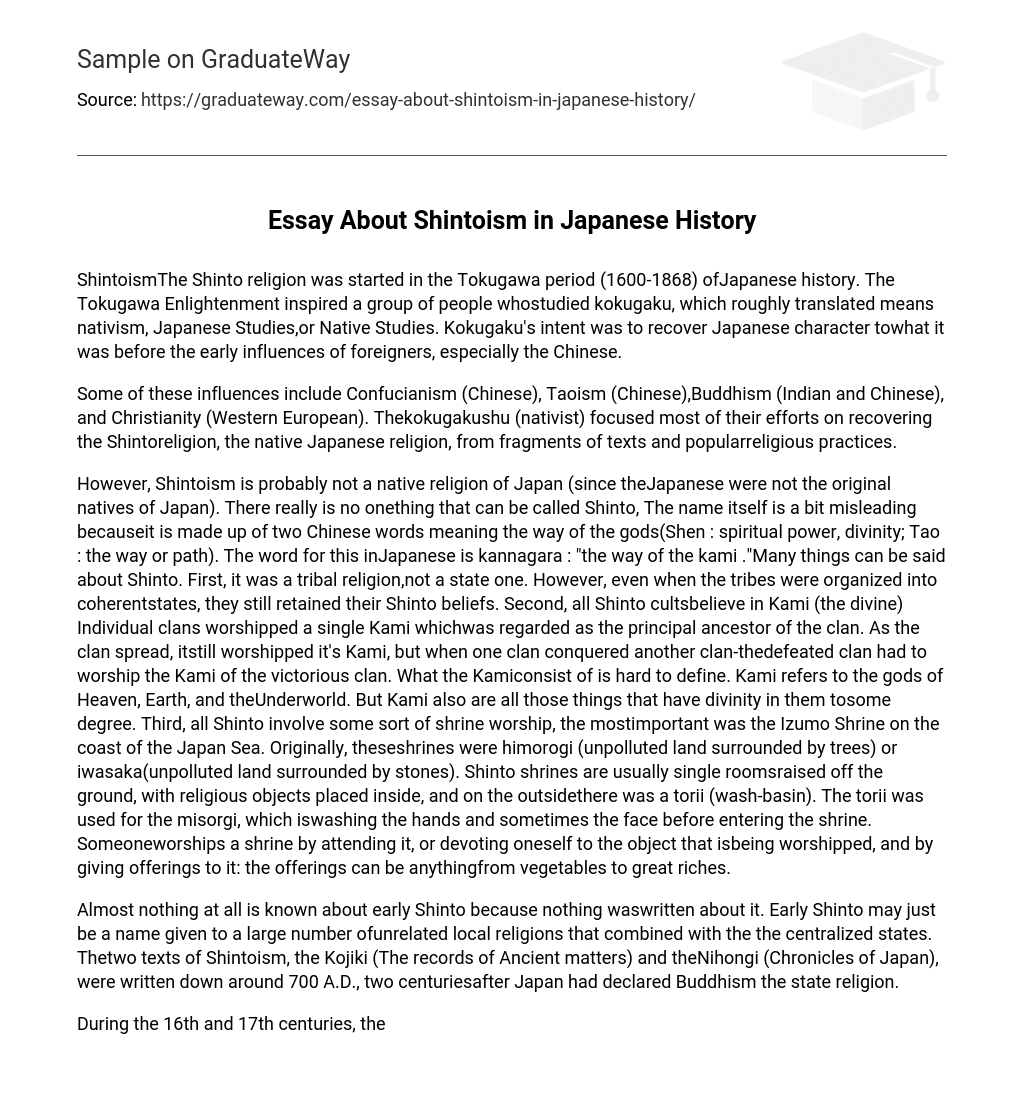ShintoismThe Shinto religion was started in the Tokugawa period (1600-1868) ofJapanese history. The Tokugawa Enlightenment inspired a group of people whostudied kokugaku, which roughly translated means nativism, Japanese Studies,or Native Studies. Kokugaku’s intent was to recover Japanese character towhat it was before the early influences of foreigners, especially the Chinese.
Some of these influences include Confucianism (Chinese), Taoism (Chinese),Buddhism (Indian and Chinese), and Christianity (Western European). Thekokugakushu (nativist) focused most of their efforts on recovering the Shintoreligion, the native Japanese religion, from fragments of texts and popularreligious practices.
However, Shintoism is probably not a native religion of Japan (since theJapanese were not the original natives of Japan). There really is no onething that can be called Shinto, The name itself is a bit misleading becauseit is made up of two Chinese words meaning the way of the gods(Shen : spiritual power, divinity; Tao : the way or path). The word for this inJapanese is kannagara : “the way of the kami .”Many things can be said about Shinto. First, it was a tribal religion,not a state one. However, even when the tribes were organized into coherentstates, they still retained their Shinto beliefs. Second, all Shinto cultsbelieve in Kami (the divine) Individual clans worshipped a single Kami whichwas regarded as the principal ancestor of the clan. As the clan spread, itstill worshipped it’s Kami, but when one clan conquered another clan-thedefeated clan had to worship the Kami of the victorious clan. What the Kamiconsist of is hard to define. Kami refers to the gods of Heaven, Earth, and theUnderworld. But Kami also are all those things that have divinity in them tosome degree. Third, all Shinto involve some sort of shrine worship, the mostimportant was the Izumo Shrine on the coast of the Japan Sea. Originally, theseshrines were himorogi (unpolluted land surrounded by trees) or iwasaka(unpolluted land surrounded by stones). Shinto shrines are usually single roomsraised off the ground, with religious objects placed inside, and on the outsidethere was a torii (wash-basin). The torii was used for the misorgi, which iswashing the hands and sometimes the face before entering the shrine. Someoneworships a shrine by attending it, or devoting oneself to the object that isbeing worshipped, and by giving offerings to it: the offerings can be anythingfrom vegetables to great riches.
Almost nothing at all is known about early Shinto because nothing waswritten about it. Early Shinto may just be a name given to a large number ofunrelated local religions that combined with the the centralized states. Thetwo texts of Shintoism, the Kojiki (The records of Ancient matters) and theNihongi (Chronicles of Japan), were written down around 700 A.D., two centuriesafter Japan had declared Buddhism the state religion.
During the 16th and 17th centuries, the Japanese government campaignedto make Shinto the national religion. However many people were unhappy withShintoism. During that time Christianity arrived in Japan. Between 1868 and1873 Christianity was severely attacked as the government shut out foreignersand their ideas. Many active Christians were killed. In 1912 the Japanese gotreligious freedom.
In 1990 the number of followers for religions in Japan are :Shintoists -112,200,000, Buddhists – 93,400,000, Christians – 1,422,000, and others -11,412,000. Therefore, about 120 million people adhere to 2 or more religions atthe same time.
Works Cited”Shinto” http://www.wsu.edu:8000/dee/Shinto.html. Online. 5June 1995.
Hishida, Miki. Religions in Japan. 15 Dec 1995. Online posting:http://naio1.kcc.hawaii.edu/miki/JReligions.html. Internet.
Religion





